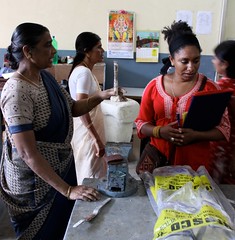By Parisa Ahmadi
Every Thursday, my classmates and I attend program sessions at the Center for Social Initiative & Management here in Bangalore. CSIM trains entrepreneurs in the skills and tools needed to uphold a social venture. They’ve invited various professionals, young and old, to talk about their experiences in the field.
The very first session we were invited to was lead by a young Indian woman. She held a managerial position at a foundation called Ashoka: Innovators for the Public. As soon as we assembled in the boardroom and she stepped up to speak, everyone was quieted by the intensity, authority, and quick-wittedness with which she spoke. She told us that the primary goal of the Ashoka Foundation is to shape the sector of entrepreneurship for social good. What is a social entrepreneur? The Ashoka Foundation website defines the term as “individuals with innovative solutions to society’s most pressing social problems. They [tackle] major social issues and [offer] new ideas for wide-scale change. Rather than leaving societal needs to the government or business sectors, social entrepreneurs find what is not working and solve the problem by changing the system, spreading the solution, and persuading entire societies to take new leaps.”
As Tanya also explained, social entrepreneurs should be encouraged to look for initiatives in their own communities, to think of creative solutions that provide resources when resources are scarce, to collaborate and share knowledge and resources, and finally, to be wary of unintended consequences, or ways they might negatively impact people despite having good intentions.
“Therefore,” Tanya explained, “in order to have a successful social venture, you need to be creative, offer systemic solutions, and be scalable and replicable.” To scale means to expand your reach, to implement social change in a way that covers more ground. But there are several ways to scale. Take the social problem of child abuse, for example:
-You can scale out: affecting more communities with child abuse.
– You can scale up: affecting policy regarding child abuse
Or
-You can scale down: narrowing your focus to one element of child abuse, such as grandfathers’ roles in the problem.
While I ruminated over all of these components of social entrepreneurship, Tanya continued to explain. She talked about one member of the Ashoka Fellowship who had created an initiative dealing with market dynamics at a national level. He had wanted to help the poor, those on the bottom of the social pyramid, so to speak, by creating new markets that included them. He also sought to increase access to goods and services, create value where it hadn’t existed, generate income for the poor, and give them more access to the flow of market information.
She has such power and conviction when she speaks, I thought as she explained the important ingredients of social ventures.  Yet even so, I could tell by the way my classmates were stirring in their seats and exchanging glances that her presentation would evoke plenty of discussion afterwards. Hands shot up and many questions were asked (some of them in the boardroom, and some of them long after the presentation was over, in moments of huddled group discourse and impassioned whispers):
Yet even so, I could tell by the way my classmates were stirring in their seats and exchanging glances that her presentation would evoke plenty of discussion afterwards. Hands shot up and many questions were asked (some of them in the boardroom, and some of them long after the presentation was over, in moments of huddled group discourse and impassioned whispers):
“So should the goal really be to bring the people on the ‘bottom of the pyramid’ to the top, or more to help the bottom help itself?”
“Is it condescending to assume the lifestyle and support network of the ‘bottom of the pyramid’ aren’t good enough for them?”
“What makes us assume we are privileged? How do we know that ‘the bottom of the pyramid’ doesn’t have robust, meaningful ways of supporting and sustaining itself?”
“Is the pyramid a good model to talk about social structure at all?”
“How do we know that we aren’t enforcing ethnocentric views in social venture, or upsetting the balance of healthy cultural ecosystems when we try to create social change?”
“For example,” someone offered, “indigenous systems of health, healing, and medical knowledge. How are we to assume their methods of healing aren’t good enough or important enough to the community?”
In the boardroom, Tanya’s response was simple:
“Indigenous systems of knowledge are important and good, but they need to be relevant. The fact of the matter is the people most affected by diseases like Malaria are those who have the worst access to mainstream health care. We don’t want to romanticize traditional lifestyles over peoples’ wellbeing.”
Tanya’s response and way of speaking was controversial among my classmates. I also hated well-worn binaries like traditional vs. modern or Western health and medicine vs. Third-World disease and ignorance being thrown around. Still, I understood where Tanya was coming from. What is the balance in being pragmatic about the distribution of resources while giving respect and value to communities various ways of living? When is social change “natural” and “good”, and when is it unnatural and forced? Furthermore, Tanya emphasized the need to scale when embarking in social venture. This, too, was controversial: the danger to scaling is that the systems intended to empower one group could disempower another. You could cause damage to a community if you don’t understand the social landscape unique to it.
So three main questions circulate in my mind after this discussion:
- What associations do we have about people we call “underprivileged,” and are they associations they share about themselves?
- How does globalization affect what we understand to be natural change in a community?
- When and how is it important to scale in a social venture?
I’ll be thinking of these as I continue to learn about social entrepreneurship. What do you think?





